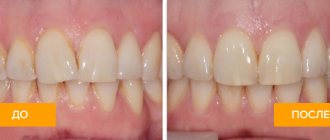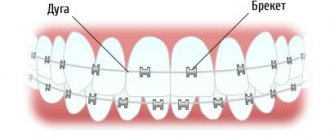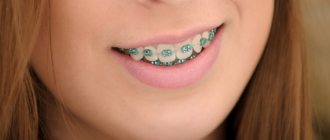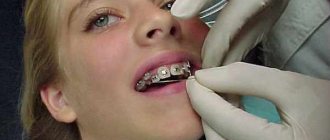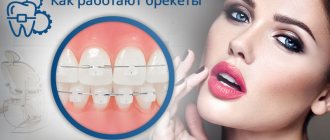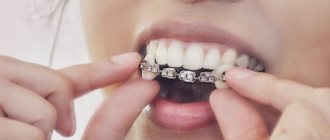709
Few people have pleasant memories of straightening teeth by wearing braces.
However, specialists in modern orthodontics do everything to ensure that the period of bite correction is as comfortable as possible.
It was for this purpose that I created 2D lingual braces. What is unique about the design, and how much the “invisible treatment” costs, you will find out further.
Manufacturer
In Germany it is a worthy competitor among many manufacturers of high-quality orthodontic products since the 70s of the twentieth century.
In the domestic market, recognition came to the European manufacturer of braces thanks to lingual designs that stand out from others due to the use of the most innovative technologies.
Developments of German specialists are used in 60 countries. High-quality structures are produced not only to eliminate malocclusions, but also to move incorrectly located bone organs in the oral cavity.
And not so long ago, the company managed to patent an innovative base for brackets, which will help increase the effectiveness of orthodontic treatment due to reliable fixation of the system.
Indications
Despite the universality of the design, the features of which you will learn further, Forestadent 2d braces have a rather limited list of indications.
The invisible system is suitable only for those with simple pathologies. That is, for those who have minor dental defects.
The main purpose of wearing lingual systems from a German manufacturer is to correct deep bites.
Contraindications
Installation of Forestadent 2d lingual braces is not possible:
- with an anatomically narrow jaw - the device requires a certain internal space in the oral cavity;
- with significant crowding of teeth or other serious abnormal placement of incisors and molars;
- patients with periodontitis or gingivitis;
- if the height of the teeth is too low , according to technology they should exceed the parameters of the brackets by 1-2 mm;
- with individual structural features of the jaw that are incompatible with “invisible” orthodontic treatment;
- with bruxism and gum diseases , which are characterized by tooth mobility.
In addition, the design is not suitable for patients with serious mental disorders, since the adaptation period may be accompanied by tongue injuries and speech disorders.
Also, Forestadent 2d braces are not recommended for children under 11 years of age.
Features and Benefits
The main design feature of lingual systems is that they are fixed on the inside of the teeth and remain invisible to others.
Accordingly, their level of aesthetics does not require discussion. The products are the flattest among all manufactured lingual structures and have a self-adjusting arch.
The adaptation period significantly reduces the rounded corners of all elements of the system, as well as their polished surface.
In addition, the height of each bracket ranges from 1.3-1.64 mm, which creates comfortable conditions when using the device.
Among the main advantages of 2d systems are:
- absence of any discomfort during operation;
- the existence of several design variations, which allows you to adapt to the individual characteristics of the jaw structure and the location of the patients’ teeth;
- the material from which the structure is made rarely causes an allergic reaction;
- absolute safety for the oral mucosa and the protective layer of the teeth;
- quick receipt of the first results of treatment - a noticeable effect of correcting the curvature of the dentition is observed after just a couple of weeks;
- excellent biomechanics, which is ensured by placing braces close to the center of the tooth. This trait is excellent for rotated and inclined bony organs of the oral cavity;
- availability – compared to analogues from other manufacturers, Forestadent 2d braces have a low price.
Correction of bite defects with Radiance braces and the effectiveness of treatment systems.
Read here about the features of Smart Clip braces.
At this address https://www.vash-dentist.ru/ortodontiya/breketyi/vestibulyarnyie/empower.html you will find out the price of Empower braces.
Comparative characteristics of modern lingual brace systems
A. F. Verapatvelyan Ph.D., orthodontist, associate professor of the Department of Pediatric Dentistry, Orthodontics and Maxillofacial Surgery of Kuban State Medical University N. I. Chechula orthodontist, assistant, graduate student of the Department of Pediatric Dentistry, Orthodontics and Maxillofacial Surgery KubSMU A.V. Topolyan , orthodontist, dental clinic “Ross-Dent” (Krasnodar)
Currently, the principles of aesthetics are becoming a priority in orthodontic treatment for both adults and adolescents. “Invisibility” and “transparency” of systems are the main requirements for orthodontic treatment. Improvement of vestibular and lingual brace systems, mouth guards makes it possible to make orthodontic correction as comfortable as possible and less noticeable to others
Orthodontic aesthetic devices can be divided into the following groups:
• lingual brace systems - ligating and self-ligating (2D and 3D);
• mouth guards - manufactured by a technician or in a specialized laboratory;
• aesthetic vestibular braces - ligating and self-ligating.
Aesthetic vestibular braces, depending on the material of manufacture, are divided into composite, plastic, ceramic or sapphire. The advantage of these systems is that they are invisible on patients’ teeth due to the transparency of the materials, although they are one third larger than metal braces.
The disadvantages include their fragility, colorability (with the exception of sapphire braces), and greater friction of the arc in the bracket groove (except for self-ligating systems and braces with a metal groove). Mouth guards are now of great interest due to the fact that they are completely transparent. This makes them more aesthetically pleasing than vestibular braces. They are removable (removed for eating and oral hygiene) and move teeth in three-dimensional space starting with the first aligner. There are many types of mouth guards, which, depending on the manufacturing technology, allow you to treat not only dentoalveolar occlusion anomalies, but also gnathic ones. Treatment with high-quality aligner systems is distinguished by its high cost compared to the vestibular or lingual brace system, as well as the difficulty of influencing the tooth root, which is reflected in the duration of the retention period.
Lingual braces have the main advantage, namely that they are “invisible”, as they are installed on the lingual surface of the teeth. Therefore, enamel demineralization or caries will not appear on the vestibular surface of the teeth during treatment.
The system is non-removable, so the lengthening of treatment due to the loss of the apparatus is reduced to zero, while the root is affected and the teeth move from body to body.
Disadvantages include long adaptation to such devices, from a week to several months depending on the choice of system, difficulty speaking during the adaptation period, difficulty in oral hygiene, eating, and the labor-intensive work of an orthodontist.
But many patients, for whom the “invisibility” of the structure, the quality and stability of the treatment result are important, opt for lingual systems. The development of lingual orthodontics began 30 years ago and has undergone significant changes during this time. Lingual braces have significantly decreased in size and become almost flat; self-ligating braces have appeared, which is especially important when an orthodontist works when replacing ligatures on the lingual surface of teeth.
If at the dawn of their development only minor dentoalveolar deformations could be corrected with lingual braces, now, with the advent of modern laboratories and three-dimensional programmed treatment planning with digital setups, it has become possible to treat any orthodontic pathologies.
• mouth guards - manufactured by a technician or in a specialized laboratory;
Photos before and after treatment with lingual braces
The photographs below show a mild clinical case where treatment with lingual braces lasted 9 months.
For each individual clinical case, after creating the primary model of the patient’s jaws, platforms for individual ready-made braces are made individually. In this case, it is possible to take into account the characteristics of each tooth and ensure maximum adherence of the braces to the surface.
Estimated cost
As already noted, installing invisible braces is quite an expensive pleasure, since the very technology of production of this design, its installation, which has some features, requires not only high-quality execution, but also the appropriate qualifications of the doctor and painstaking maintenance.
This is what determines the high cost of the braces system.
It is important to remember that braces require correction or activation, that is, replacement of arches. The cost of these procedures is not included in the total cost. The approximate cost, in total, is from 130,000 to 530,000 rubles. However, the cost is not final; only an orthodontist can tell more exact costs.
- For diseases of the teeth and gums, in particular in the presence of periodontitis, periodontal disease, and gingivitis.
- In the presence of teeth grinding, during sleep.
- If you are allergic to the components of the structures.
- In case of deviation of the temporomandibular composition.
- With short teeth.
- For twisted teeth or thin crowns.
- Up to 11 years of age.
Flaws
Like all orthodontic structures, the products have negative qualities. Among them are:
- installation of the system requires lengthy preliminary preparation;
- during the adaptation period, diction disorders and minor injuries to the tongue may be observed, but these consequences quickly pass;
- not all orthodontists undertake the complex task of installing a lingual system, since fixing the elements of the apparatus on the inside of the teeth is much more difficult than on the outside;
- the period of wearing lingual braces can significantly exceed the duration of treatment with the vestibular apparatus;
- a significant list of contraindications for installing the structure;
- it is necessary to devote more time to oral hygiene.
Lingual braces. Combining convenience and aesthetics in one system
From the article you will learn:
The vast majority of people in different parts of the world dream of a beautiful smile and straight teeth. However, even those who have the opportunity to make their teeth perfect do not always use this opportunity. Many patients are seriously embarrassed by the long treatment procedure, during which they need to constantly wear corrective braces on their teeth, which do not always look aesthetically pleasing. And therefore they avoid in every possible way visiting a specialist who could help them.
For such patients, a special braces system was created, called lingual (in another way it can also be called internal). The special design of such systems allows them to be attached to the inside of the teeth and makes the device completely invisible to outsiders. Lingual correctors, like conventional systems, do a good job of straightening teeth, and therefore are becoming increasingly popular among people who plan to use them to correct dental malocclusion.
The vast majority of people in different parts of the world dream of a beautiful smile and straight teeth. However, even those who have the opportunity to make their teeth perfect do not always use this opportunity. Many patients are seriously embarrassed by the long treatment procedure, during which they need to constantly wear corrective braces on their teeth, which do not always look aesthetically pleasing. And therefore they avoid in every possible way visiting a specialist who could help them.
What are the benefits of lingual braces?
All the disadvantages of this brace system are associated with the difficulties of the adaptation period. In particular, braces on the inside of the teeth cause temporary impairment of diction. Therefore, for those who are very worried about this, it is better to start treatment while on vacation. Another drawback that appears in the first days after installation is increased salivation. In addition, there is a possibility of injury to the tongue due to lack of habit.
Adaptation and care
Lingual braces require longer adaptation than regular braces - from 2 to 4 weeks. At this stage, discomfort, impaired diction, and increased salivation may occur. Injuries to the tongue are very rare, and are more classified as myths - the tongue quickly gets used to foreign bodies on the teeth.
To care for braces you will need:
- Orthodontic or electric toothbrush;
- Special thread for cleaning fixed structures;
- Irrigator.
You also need to be careful about your food - do not eat hard or heavily fried foods, and avoid temperature changes.
Lingual braces are placed on the inside of the teeth.
Lingual braces require longer adaptation than regular braces - from 2 to 4 weeks. At this stage, discomfort, impaired diction, and increased salivation may occur. Injuries to the tongue are very rare, and are more classified as myths - the tongue quickly gets used to foreign bodies on the teeth.
Types of lingual braces
1. Metal Stb braces are self-ligating. Due to the fact that there is minimal friction between the latch and the arc of this design, treatment is faster.
System Features:
- The correction of teeth is made more precise by the low load that moves the teeth.
- You can eat food with such briquettes without any problems.
- The design hardly interferes with diction.
- The briquette system is comfortable to carry, as it is small in size.
- Caring for metal plates is easy.
- Children as young as eleven years old can wear such braces.
2. Individual lingual briquettes Incognito are manufactured using innovative technologies in Germany. They are individual, so they are very effective, but at the same time, they are quite expensive. Thanks to modeling and computer control, as well as precise milling, Incognito briquettes are ideal for every clinical case. Made from an alloy that contains gold, the bracket system is hypoallergenic.
3. Inovation - L ligature-free systems, due to their reduced size and reliable fixation, do not rub the tongue and do not cause discomfort. The first results after installing such a system will be visible within a few months. Designs are made taking into account all the features of the dentition.
4. Forestadent 2 d flat braces have a highly polished surface and low height. Due to this, they do not violate diction and do not interfere with the language at all. Getting used to flat braces is quick and easy. Another advantage is their reasonable price.
I’ve been wearing invisible cameras for six months now and I’m very glad that I installed them rather than an external system, although the price was tempting. I just didn’t really want to walk around with these scary pieces of iron. And now I'm happy with the aesthetics. I practically don’t feel any discomfort, except during cleaning and eating. But the teeth have already noticeably straightened out . Now we just have to wait for the final result.
System installation
Since braces are fixed on the inside of the teeth, the specialist’s work becomes much more complicated. An orthodontist must have a high level of professionalism and a certain amount of knowledge.
In general, the installation process consists of the following algorithm of actions:
- Taking an impression of the dentition. For this purpose, special dental plaster is used.
- Creation of a computer model of the jaws and bite as a result of treatment based on the impression obtained.
- Making a model of the orthodontic apparatus from wax and fixing it on the cast.
- Production of a system that will be installed directly on the patient's teeth.
To do this, the design model is filled with plaster, and the wax in the mold cavity is melted. Next, the workpiece is filled with liquid metal. The arc is manufactured using computer technology on automatic equipment. - Preparing the oral cavity for installation. At this stage, caries and associated diseases are treated, and professional cleaning is performed, during which tartar is removed. As a rule, this takes at least 2-3 weeks.
- Installation of the structure. Jewelry work by an orthodontist takes on average up to 3 hours.
Afterwards, the specialist determines the frequency of visits to his office in order to monitor the treatment.
Braces systems / brackets / orthodontic brackets – review
Over the course of a year, I asked friends and acquaintances and asked them to recommend an orthodontist (proven!). I read a large number of resources on this topic on the Internet and realized that I wanted to find an orthodontist who pays special attention to joints. After all, now, as it turns out, there are a large number of scammers who do not heal, but cripple. They straighten the teeth in the oral cavity, but they don’t care much about what happens to the joints. As a result, such treatment will cost you not only money, but also health. And the result will not be saved.
Wearing time and effectiveness
The duration of wearing Forestadent 2d braces depends on the severity of the defect. As practice shows, treatment with a flat system takes 1-1.5 years. The adaptation period when wearing a German device passes practically without complications and in the shortest possible time. Quite rarely, during the period of adaptation, patients experience speech impairment, increased salivation, and damage to the tongue.
Patients observe the first positive results of wearing the structure a month after installation.
In general, the duration of treatment is affected by:
- type of defect and degree of its severity;
- patient's age;
- compliance with all specialist recommendations regarding the rules of system operation.
Care
In order to ensure high-quality oral hygiene during orthodontic treatment, you will need:
- an electric brush or a brush specially designed for the structure;
- irrigator;
- thread for cleaning fixed devices.
You will also have to reconsider your diet. As with most orthodontic systems, you will have to forget about eating hard and sticky foods during treatment.
What is the In Ovation bracket system and indications for using the structure.
In this article we will talk about how you can straighten your front teeth without braces.
Follow the link https://www.vash-dentist.ru/ortodontiya/breketyi/vestibulyarnyie/inspire-ice.html if you are interested in the pros and cons of Inspire Ice braces.
Features of Forestadent braces
- scientific development base: the company maintains contact with doctors from private clinics and scientists from many universities. Before entering the market with a new product, the company carefully tests it in practice, which allows us to say that it has an extensive clinical base. In addition, many scientific works of European universities in the field of orthodontics are based on the products of this company,
- wide range: striving for constant product innovation, Forestadent maintains popular and sought-after braces models in production. The company develops aesthetic ceramic and sapphire systems, high-tech self-ligating braces. But classic metal braces continue to be actively improved, as they find their patients,
- patented base of each bracket: to make the attachment of the bracket to the enamel more durable, you need to give its base more relief. Due to this, the contact area with the adhesive composition increases. Usually, for this purpose, meshes and furrows are applied to it. The company's patented base is covered in hook-like ridges with beveled edges. Thanks to this, the bracket is firmly fixed to the enamel surface. In addition, this protects the ceramic and sapphire plates from chipping, including during removal,
- special shape of braces: company specialists conducted a study, studying the shape of more than 4 thousand teeth of patients around the world. This allowed them to customize each bracket based on the anatomical features identified during the study. Thanks to this, the attachment of braces to the tooth has become stronger, and wearing them has become more comfortable,
- hypoallergenic arches: as in the creation of metal braces, nickel-free alloys are used in the development of tying arches, which makes the structures completely hypoallergenic,
- additional orthodontic devices: in addition to braces and components for them, the company also produces functional devices for correcting bites - mini-screws to enhance the impact on part of the teeth simultaneously with installed braces, twin blocks, palatal arches, etc.
Prices
The cost of Forestadent 2d braces consists of several components, each of which depends on a number of factors. For example, the price of the structure itself (for one jaw) in different clinics in the capital fluctuates between 25-30 thousand rubles.
The stage of preparing the oral cavity for installation, which includes diagnosing and eliminating oral problems, can cost 7-50 thousand rubles, depending on the patient’s medical history.
The cost of a specialist’s work, which includes fixation, adjustment, removal of the system and selection of retainers, costs future owners of a “Hollywood smile” 25-80 thousand rubles . As a result, correcting a turnkey bite using German technology costs 57–160 thousand rubles.
How much do 2D braces cost?
When compared with other lingual brace systems, 2D solutions are quite affordable in price. The minimum cost of installing such a device is 40 thousand rubles per jaw, which can be compared with fixation with a vestibular aesthetic design.
Analogs
Today there are many identical designs to the Forestadent 2d system on the market. Among the most popular are the following:
- Metal braces Stb . They are distinguished by their miniature plates and small area of attachment of the main elements, due to which they are practically imperceptible in the oral cavity.
However, the described advantages often turn into a disadvantage, since the device comes off due to unreliable fastenings to the enamel. The minimum cost of a mini-system is 70 thousand rubles. - Win system bracket . The manufacturing process of an orthodontic appliance with thin plates is fully automated, and allows you to adjust the design to the individual characteristics of the jaws of each patient.
The elastic arch easily changes the angle of fixation. Therefore, an effective system can solve many malocclusion problems. The cost of the design for one jaw ranges from 130 thousand rubles. - Incognito braces. Their uniqueness lies in complete computerized control during product manufacturing, which reduces the likelihood of inaccuracies in the parameters of the finished design.
In addition, in the production of Incognito, an alloy with gold is used, which provides them with reliable strength.German-quality devices also have thin plates, have no age restrictions, and are able to correct even the most serious bite problems. Patients are only confused by the high cost (from 200 thousand rubles) and the long production time.
Learn about new technologies in the production of Forestadent braces from the video.
What are they?
Lingual braces 2d come in the following types:
- "STB" systems made of metal. They can be used from 11 years of age. They reduce friction. The teeth move to the right place with a natural minimum load. Comfortable to wear due to its small size. They almost do not interfere with diction and do not interfere with eating. The period of getting used to them is quite short.
- “Incognito” are individually manufactured systems that are very popular and highly expensive. Produced by a German company using innovative technologies. They are usually made from a gold-containing alloy. They are quite thin, so they cause minimal discomfort when worn. They are used for patients of all ages, but are especially popular among young people.
- "Forestadent 2D" - the flattest products. When using them, there is no restriction of tongue movement and no discomfort. The result can be noticed already from the first months of correction. The price is relatively affordable. They can be produced in two ways: standard or customized using 3D modeling (via high-precision casting). The second type is smaller and more convenient than the first, but the price of such braces is higher due to the labor-intensive manufacturing process. Non-ligature “BioQuick” metal structures are also considered a variety of such systems. They are self-ligating, low profile and fit perfectly to the teeth.
- “Inovation L” are ligature-free braces with a special interactive latch, which eliminates the need to use ligatures. Comfortable to use. They fit very securely and are easy to clean. Treatment when using them takes place in less time.
- “Win” braces are made to order. The process is automated, which makes it possible to maximally adjust the product to all the features of the jaw. The arc is elastic and easily changes the angle of fixation.
Next, the Forestadent 2D designs will be discussed in more detail.
Reviews
Most owners of Forestadent 2d braces are satisfied with the results. Moreover, treatment with this system is much cheaper than correcting a bite with similar designs from other manufacturers. If you are ready to share your opinion on this matter, leave a comment below the article.
If you find an error, please select a piece of text and press Ctrl+Enter.
Tags braces lingual braces
Did you like the article? stay tuned
Previous article
CSM implants – reliable and inexpensive replacement of dental elements
Next article
Semados implants - review of products from a German manufacturer



